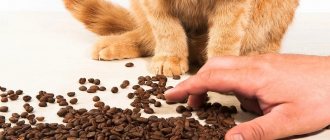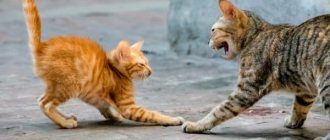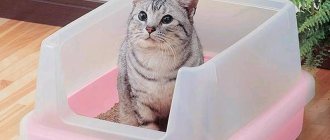Often cats suddenly develop health problems, and the owner does not know what to do or how to help the pet. If the cat cannot go to the toilet in a small way, then, of course, you need to quickly contact a veterinarian. In our article we will try to explain in more detail the problems of this disease, what the causes of this condition may be, and how to provide all possible help to your pet.
How much should a cat urinate normally?
Before moving on to the description of deviations, it is important to mention the recommended standards. Changes in the usual volume of urine and the frequency of trips to the toilet will tell you about the pathology.
Volumes
The exact indicator is determined individually based on the following factors:
- Type of food.
When feeding “natural” food, the body receives not only clean water, but also liquids from foods. This is reflected in the volume of allocations.
- Weight.
Obese animals have less bladder control, so their litter box needs to be changed frequently.
- Age.
Unlike an adult, a kitten is simply not able to make a puddle that is too large due to its size.
- Floor.
During pregnancy, a cat pees more than a cat due to constant pressure on the uterus.
On average, the volume of liquid coming out is 50-200 ml. It can be measured with a measuring cup, after removing all the filler from the tray in advance.
Frequency
Before puberty, kittens pee up to 5 times a day. With age, the frequency of urination decreases by 1-3 times.
The number of trips to the toilet periodically increases during estrus and pregnancy - or remains at the kitten level after castration. In the absence of other alarming symptoms, both phenomena are completely normal.
What to do?
Choosing the right algorithm of action if the cat did not write much the day before is not so difficult.
© shutterstock
Self-treatment
First, you need to remember everything that happened to her in recent days. Perhaps you transported your pet from one place of residence to another? Probably the cause of all the troubles is increased nervous tension. In this situation, you should ensure that your cat is as comfortable as possible. If the tray has been dry for the second day, and the cat periodically comes up and sadly paws at the litter, it may not be entirely comfortable for him in his own toilet. The fact is that if proud cats don’t like something, they will endure it on principle. Perhaps the tray has not been cleaned for a long time or there is not enough filler in it.
Try tidying up or adding pellets to the toilet. Also check to see if your cat is thirsty. Has the water decreased since the last time you filled the bowl? If not, you should force the cat to drink.
What symptoms should you be wary of?
In addition to urinary retention itself, accompanying symptoms can indicate the presence of a problem. These include:
- apathy and depression;
- severe thirst, deterioration or loss of appetite;
- abdominal growth not associated with obesity or pregnancy;
- increased body temperature;
- sleep disturbance;
- swelling of the paws and neck;
- vomiting and diarrhea;
- bending of the hind legs, their uncharacteristic stretching or the appearance of convulsions.
If you notice at least a few of the listed symptoms, you should contact your veterinarian. Otherwise, the cat risks dying from intoxication with decay products.
Prevention of diseases associated with difficulty urinating
Problems with urination appear especially often in castrated, neutered, elderly, weakened animals and in obese cats.
Preventive measures should include:
- regular examination by a veterinarian and strict compliance with all instructions issued by the doctor;
- control of the animal's weight. Obesity causes a malfunction in many body systems, primarily the excretory system;
- compliance with a corrective diet;
- monitoring compliance with the drinking regime;
- preventing animal hypothermia;
- complete rejection of salt in cat food and other salty foods: smoked meats, sausage, salted meat and fish.
Attentive attitude towards your pet will allow loving owners to promptly identify and eliminate problems associated with urinary retention.
How to understand that an animal has urinary retention
Urinary dysfunction is very easy to diagnose yourself. Due to an overcrowded bladder, the cat experiences severe pain, and the urine itself changes its color and consistency.
Main symptoms include:
- aggression when palpating the abdomen;
- reducing the volume of urine and increasing the frequency of trips to the toilet;
- leaving puddles or small droplets outside the tray (due to pain, the cat avoids the tray and sits down to relieve itself throughout the house);
- frequent licking of the genitals;
- the appearance of mucus, pus or blood in the urine, as well as a change in its odor.
There is no point in scolding your pet at this time. Your negative reaction will only worsen his condition due to stress. The former cleanliness will return immediately after recovery, so just concentrate on eliminating the problem.
What is the cause of urinary problems?
Difficulty or cessation of urination develops when the lumen is narrowed or the excretory channels are blocked.
Difficulty or cessation of urination develops when the lumen is narrowed or the excretory channels are blocked.
In addition to chronic diseases, which will be discussed in more detail below, the following causes of the pathological condition are distinguished:
- Congenital pathologies. There are breeds of cats, as well as individual individuals, that are prone to chronic kidney and urinary tract diseases.
- Unbalanced diet. Ready-made economy-class food, available in abundance on supermarket shelves, consists mainly of by-products and plant components. Most of their components are not digested and turn into nitrogenous waste. They precipitate or alkalize the urine. Conditions are created for the formation of urinary stones. Excess phosphorus, calcium, magnesium also contributes to the formation of stones. Therefore, the cat rarely goes to the toilet in small ways.
- Violation of containment conditions. Cats cannot stand heat, drafts or cold floors. Overly caring housewives often bathe cats, which increases the risk of hypothermia and colds that result in kidney damage.
- Consequences of sterilization. It is impossible to sterilize animals that have not yet grown: body weight increases, but the diameter of the urinary canals remains the same, which increases the risk of blockage.
- Injuries. Males are most often affected. The tissues of the penis are affected, adhesive inflammation occurs, in which the urethra narrows. When the spine is damaged, innervation is disrupted.
- Stress. A long move, participation in an expert exhibition, the operation of household appliances, communication with dogs causes spastic contraction of smooth muscle organs, suspending physiological functions for a day or two.
- Obesity. Lack of movement and overfeeding predispose to the occurrence of urogenital pathologies.
- Old age. Cats develop chronic diseases of the urinary organs, their innervation is disrupted.
Be sure to read:
The cat tagged: how to remove odors, the best folk and chemical remedies, how to wash clothes and shoes
What disorders cause difficulty urinating?
Depending on the existing disorder, urine is completely or partially absent - or it encounters an obstruction at the exit. In the first case, the cause usually lies in renal pathologies, and in the second, in blockage of the urethra due to excitement, trauma, infections and stones.
Sexual arousal
Most often, during sexual hunting, owners complain about the opposite problem - frequent urination in females and leaving marks in males. But excitement also leads to enlargement of the gonads with subsequent compression of the urethra.
Injuries
After an accident and falling from a height, a cat can damage its internal organs. In this case, the delay is explained by the loss of their functionality, and the presence of blood in the urine is due to internal bleeding.
Cystitis and other bladder diseases
The most common reason why a cat cannot pee is cystitis. Inflammation in the bladder is usually caused by bacteria that enter there directly or from neighboring organs. The pathology is accompanied by severe pain, increased urge and a gradual reduction in the volume of fluid to a few drops.
Advanced cystitis is often complicated by urethritis. With this disorder, the inflammatory process covers the urethra. It can be diagnosed by purulent discharge and a strong odor of acetone or ammonia from the pet's skin.
Urolithiasis disease
When there are too many stones in the ureter, a blockage occurs. Every attempt to urinate is accompanied by acute pain due to stones that injure the delicate mucous membrane. The blood emerging from numerous wounds turns the urine pink or comes out in separate clots.
“
Read more about urolithiasis in cats
Renal pathologies
Of all the kidney diseases in cats, kidney failure is the most common. It occurs when there is blockage and compression of the urinary tract, a sharp decrease in the amount of blood circulating through the kidneys, and direct dysfunction of the organ. The last case has the most unfavorable prognosis, since damaged kidney cells are not able to recover.
Can cats stop peeing at night?
Since cats can hold their urine for up to 48 hours, it is no problem for them not to pee at night. However, this should not be a reason for you not to have a litter box in your home! Indoor cats should always have access to a litter box.
It is very dangerous if your cat stops urinating, so don't hesitate to take her to the vet if you notice any problems or changes in routine. The sooner you give your cat the treatment it needs, the easier it will be to treat it.
Article Author: Roland Jacob Roland has been an animal lover all his life, and cats have a special place in his heart. He is owned by three felines: Willie, KitzKitz and Nugget (all rescues), who bring all the laughter and mischief you would expect from a race of cat owners.
First aid: what to do if the cat cannot pee?
Veterinarians recommend not to self-medicate and seek help immediately. Otherwise, there is a risk of worsening the condition due to incorrect selection of the drug and its dosage.
You can provide first aid only when you are unable to deliver your cat to a veterinary clinic in the near future. But even in this case, you need to contact the doctor at least by phone in order to receive detailed instructions from him.
Acceptable Actions
If you do not have sufficient experience in palpation and massage, then it is better to avoid these actions. Too much squeezing can cause injury to the mucous membrane and even rupture of the bladder.
A cat showing signs of thirst can be given some water from a dropper or light chicken broth. But you shouldn’t force drink. In case of renal failure, this will increase swelling and create additional stress on the overcrowded organ.
“ Kind words and not too active games will contribute to a temporary improvement in the condition. They will help distract you and reduce accompanying symptoms.
On the recommendation of a doctor, you can give an antispasmodic or pain reliever. They will help eliminate urethral spasm and pain.
Prohibited actions
If your cat has problems with urination, then under no circumstances use warming compresses. In case of intoxication, additional heat will only accelerate the spread of infection.
It is also prohibited to give medications without first obtaining advice. Antispasmodics increase bleeding, and diuretics increase the volume of internal fluid. To prescribe them, it is necessary to know the exact or at least presumptive diagnosis made by a veterinarian.
Urgent medical care
First aid in a veterinary clinic involves inserting a catheter. Only a professional should insert a catheter, after first flushing the bladder with antiseptics. This operation is painful, so it is performed under general anesthesia. After catheterization, the veterinarian performs a series of tests to find the cause of urinary retention.
Important: you should not insert a catheter often - after this procedure, swelling of the urinary tract occurs. If the doctor sewed in a catheter for several days, you need to keep the cat in a special collar during this time so that it does not injure itself and does not remove the catheter.
Diagnostics in a veterinary clinic
Urinary retention and its cause are determined on the basis of palpation, ultrasound and x-ray of a congested organ. In addition to bladder enlargement, these tests help diagnose kidney problems, tumors and stones.
Additionally, blood and urine tests are taken from the mustachioed patient. With their help, the causative agent of infection, the type of stones and the level of intoxication of the body are identified.
How long can my cat go without peeing?
Research shows that a healthy cat's bladder is always functional and active. However, these felines can hold urine for up to 24 to 48 hours even after drinking large amounts of liquid.
Although kittens usually don't urinate for two days, a cat that doesn't pee for more than 48 hours should be cause for concern. Unfortunately, this action may indicate that your feline friend may be at serious risk of injury or death.
Relieving the animal's condition and treatment
The patient's condition is alleviated by inserting a catheter and taking medications. It is also mandatory to prescribe a therapeutic diet that includes a reduced intake of proteins and fats.
Catheterization
In especially severe cases, catheterization is carried out even before ultrasound. With its help, all excess fluid is removed, and the urethra is washed from toxic urine products.
The procedure is carried out under anesthesia, and if large stones are detected, it is combined with urethrostomy - the creation of an additional hole for urine drainage and the subsequent installation of a permanent catheter.
Medication treatment at home
Drugs are selected individually based on the diagnosed cause. Sexual heat is simply waited out or eliminated by castration.
With injuries, everything depends on their severity. This often requires the help of a surgeon. If the problem lies in diseases of the bladder and kidney pathologies, then the mustachioed patient is prescribed:
- antibiotics and antivirals that destroy the infectious agent;
- diuretics, stimulating the outflow of urine;
- anti-inflammatory, suppressing the inflammatory response;
- rehydration solutions that normalize water balance;
- hemostatic agents that improve blood clotting;
- detoxification drips that eliminate the effects of poisoning;
- cardiogenic, stabilizing the heart;
- analgesics and antispasmodics that relieve pain and spasms.
The decision to stop treatment is made by the doctor based on tests. Stopping it too early or reducing the dosage can result in a sharp deterioration in the condition and the emergence of new complications.
Features of physiology
Cats have a specific physiology. For many millennia, these animals survived in desert landscapes with very little water. Because of this, cats began to drink less than other animals (such as dogs). The cats made up for the lack of water with liquid that they got from food. This feature remains unchanged today: cats still drink little, so they need food with a high fluid content.
Due to their physiology, cats' kidneys produce very concentrated urine. The specific gravity, or density, of urine shows the amount of substances dissolved in it. The gravity of cat urine is usually above 1.040. A reading below 1.020 indicates problems with the kidneys. For comparison, distilled water has a reading of 1.000, while human urine ranges from 1.002 to 1.030.
Therapeutic diet
Natural cats are put on a low-calorie diet that excludes the consumption of fatty meat, fish and milk. The list of permitted foods depends on the acidity level (pH). At a high value, oxidizing products are used (liver, veal, egg whites, boiled fish, chicken), and at a low value, alkalizing products are used (spinach, carrots, broccoli, egg yolks, fresh cottage cheese).
A sick pet eating dry food is transferred to a treatment line for animals with urinary dysfunction. Such nutrition reduces the load on the liver, destroys stones and normalizes urine output.
How to avoid diseases of the genitourinary system
To prevent your pet from having urinary problems, the following rules should be followed:
- ensure correct conditions of detention;
- control the weight of the animal;
- carry out regular deworming, vaccinations, preventive examinations;
- do not abuse treats, do not feed food from the human table;
- use ready-made super-premium food.
Be sure to read:
How many times should a cat go to the toilet, small and large?









